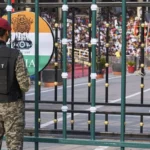Introduction
In a historic turn of events, India’s use of the BrahMos supersonic cruise missile in active combat operations has dramatically shifted the power balance in the region. The strikes, part of Operation Sindoor, targeted several critical Pakistani air bases and installations, leading to a swift US-brokered ceasefire. This blog breaks down how these strategic hits—especially the one on Noor Khan Air Base—crippled Pakistan’s military options and forced an end to hostilities.
Why India Deployed BrahMos
The BrahMos missile deployment came in response to Pakistan’s attempted attack on New Delhi using Fatah 2 ballistic missiles. The missiles were successfully intercepted near Sirsa by India’s S-400 Air Defence System. India’s retaliatory response, however, was far more decisive. Using Sukhoi Su-30MKI fighter jets, India launched BrahMos missiles deep into Pakistani territory, marking the missile’s first use in combat.
Top 7 BrahMos Strikes That Changed the Game

- Noor Khan Air Base (Chaklala, Rawalpindi): The crown jewel of the strikes. This highly fortified base, just 10 km from Islamabad, had its airstrip and road networks destroyed, cutting off Pakistan’s access to key nuclear assets.
- Rafiqui Air Base (Shorkot): A major operational base in Punjab, damaged in the initial wave.
- Murid Air Base (Chakwal): Hit to disrupt forward-operating fighter deployments.
- Rahim Yar Khan & Sukkur Bases: Targeted to suppress logistics and radar surveillance operations.
- Chunian Radar Station (Kasur): Precision targeting of radar installations to blind air defences.
- Pasrur & Sialkot Installations: Destroyed critical surveillance capabilities near the LoC.
- Skardu, Bholari, Jacobabad, and Sargodha Airfields: Widespread damage reported, limiting Pakistan’s response capability.
The Tactical Objective: Undermining Nuclear Posture
India’s strategic aim was clear: challenge Pakistan’s ability to threaten nuclear retaliation. By disabling access points to nuclear assets, India neutralized any bluff of escalation. “This was a psychological and tactical blow,” said military sources, “not just military suppression.”
Ceasefire Under Pressure: The US Steps In
)
As Pakistan’s air defence crumbled, global concern mounted. US President Donald Trump announced the ceasefire via Truth Social, signaling an end to escalating violence. However, Pakistan violated the truce within hours, highlighting its habitual pattern of using ceasefires as face-saving measures.
Expert Views: Pakistan’s Strategy Was a Ruse
Retired military experts unanimously agree that Pakistan’s posturing was not aimed at winning a war, but at engineering a stalemate under international pressure. “This is their playbook—escalate tension, provoke global concern, then posture as equals,” noted Col S Dinny (Retd). “But this time, India didn’t blink.”
The New Normal: No Tolerance for Terror
The Indian government has now drawn a red line—any act of terror will be treated as an act of war. “India has declared a new normal,” said Cmde Srikant (Retd). “We’ve entered a phase where deterrence is clear, targeted, and uncompromising.”
Conclusion: A Turning Point in Indo-Pak Relations
India’s bold use of BrahMos missiles marks a pivotal shift in South Asia’s security architecture. It demonstrated not only precision-strike capability but also a new policy posture—swift retaliation, nuclear confidence, and political resolve. As tensions ease for now, one thing remains certain: India’s strategy has changed the rules of engagement with Pakistan.
For more updates on Operation Sindoor, read our full mission briefing summary.








